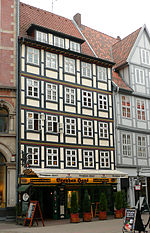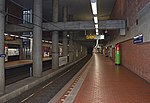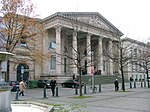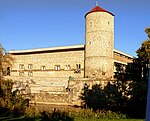Marktkirche, Hanover

The Marktkirche St. Georgii et Jacobi (Market Church of Sts. George and James), commonly known as Marktkirche ("The Church on the Marketplace"), is the main Lutheran church in Hanover, Germany. It was built in the 14th century and, together with the nearby Old Town Hall, is considered the southernmost example of the North German brick gothic (norddeutsche Backsteingotik) architectural style. The roof and the vaults of the naves were destroyed in an air raid in 1943 and restored in 1952. The church is a hallenkirche (hall church). Above the nave and two aisles rises a monumental saddleback roof. The high western tower was a symbol for the power and the wealth of the citizens of the town. It is still one of the highest towers in Lower-Saxony and a landmark of the city.
Excerpt from the Wikipedia article Marktkirche, Hanover (License: CC BY-SA 3.0, Authors, Images).Marktkirche, Hanover
Markt, Hanover Centre (Centre)
Geographical coordinates (GPS) Address Nearby Places Show on map
Geographical coordinates (GPS)
| Latitude | Longitude |
|---|---|
| N 52.371666666667 ° | E 9.735 ° |
Address
Martin Luther
Markt
30159 Hanover, Centre (Centre)
Lower Saxony, Germany
Open on Google Maps










